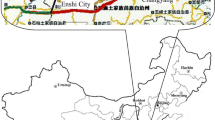Abstract
For its complicated depositing environment of surrounding rock mass for underground roadways, it is a very important work to back-calculate the mechanical parameters of surrounding rock mass by measurement displacements. To overcome the shortcomings of the traditional neural networks, a new neural network based on black hole algorithm has been proposed. Then, a new back analysis method based on new neural network has been studied. Using this new back analysis method, the mechanical parameters of surrounding rock mass for two deep roadways in Huainan coal mine of China have been back-calculated based on the measurement convergence displacements. Moreover, the good performance of the new back analysis method has been compared with those by back propagation network, neural networks based on genetic algorithm and immunized evolutionary programming proposed in previous studies. The results show that, using the back-calculated parameters, the computed displacements agree with the measured ones. And, considering the computing effect and efficiency comprehensively, the new back analysis method is the good method to determine the suitable mechanical parameters of surrounding rock mass for underground roadways.














Similar content being viewed by others
References
Angeline PJ, Saunders GM, Pollack JB (1994) An evolutionary algorithm that constructs recurrent neural networks. IEEE Trans NN 5:54–65
Bouchekara HREH (2014) Optimal power flow using black-hole-based optimization approach. Appl Soft Comput 24:879–888
Deng JH, Lee CF (2001) Displacement back analysis for a steep slope at the three gorges project site. Int J Rock Mech Min Sci 38:259–268
El-Hawary ZME (2014) Optimal power flow by black hole optimization algorithm. In: McDonald J (ed) 2014 Electrical Power and Energy Conference. IEEE Press, New York, pp 134–141
Feng XT, Zhang ZQ, Sheng Q (2000) Estimating mechanical rock mass parameters relating to the Three Gorges Project permanent shiplock using an intelligent displacement back analysis method. Int J Rock Mech Min Sci 37:1039–1054
Feng XT, Zhao HB, Li SJ (2004) A new displacement back analysis to identify mechanical geo-material parameters based on hybrid intelligent methodology. Int J Numer Anal Meth Geomech 28:1141–1165
Freeman JA, Skapura DM (1991) Neural networks-algorithms, applications, and programming techniques. Addison-Wesley Publishing Company, New York
Gao W (2016) Displacement back analysis for underground engineering based on immunized continuous ant colony optimization. Eng Optim 48(5):868–882
Gao W, Liu QS (2009) Back analysis of underground engineering based on bionics computation intelligence-methods and applications. Science Press, Beijing (in Chinese)
Gao W, Ge MM (2016) Back analysis of rock mass parameters and initial stress for the Longtan tunnel in China. Eng Comput 32(3):497–515
Gao W, Yin ZX (2011) Modern intelligent bionics algorithm and its applications. Science Press, Beijing (in Chinese)
Hatamlou A (2013) Black hole: a new heuristic optimization approach for data clustering. Inf Sci 222:175–184
Jin F (2000) Neural computing intelligence foundation-principles and method. Xi’nan Jiaotong University Press, Chengdu (in Chinese)
Liang YC, Feng DP, Liu GR, Yang XW, Han X (2003) Neural identification of rock parameters using fuzzy adaptive learning parameters. Comput Struct 81:2373–2382
Liu QS, Gao W, Yuan L (2010) Stability control theory and supporting technology and application for deep coal mine rock roadway. Science Press, Beijing (in Chinese)
Maier G, Gioda G (1982) Optimization methods for parametric identification of geotechnical systems. In: Maitins BJ (ed) Numerical methods in geomechanics. Springer, Berlin, pp 431–436
Moreira N, Miranda T, Pinheiro M, Fernandes P, Dias D, Costa L, Sena-Cruz J (2013) Back analysis of geomechanical parameters in underground works using an evolution strategy algorithm. Tunn Undergr Space Technol 33:143–158
Ochmanski M, Bzowka J (2012) Back analysis of SCL tunnels based on artificial neural network. Archit Civ Eng Environ 3:73–81
Pichler B, Lackner R, Mang H (2003) Back analysis of model parameters in geotechnical engineering by means of soft computing. Int J Numer Meth Eng 57:1943–1978
Rechea C, Levasseur S, Finno R (2008) Inverse analysis techniques for parameter identification in simulation of excavation support systems. Comput Geotech 35:331–345
Vardakos S, Gutierrez M, Xia CC (2012) Parameter identification in numerical modeling of tunneling using the Differential Evolution Genetic Algorithm (DEGA). Tunn Undergr Space Technol 28:109–123
Wu YK, Yuan HN, Zhang BY, Zhang ZL, Yu YZ (2014) Displacement-based back-analysis of the model parameters of the Nuozhadu High Earth–rockfill Dam. Sci World J 2014:1–10
Yao X, Liu Y (1997) A new evolutionary system for evolving artificial neural networks. IEEE Trans NN 8:694–713
Yu YZ, Zhang BY, Yuan HN (2007) An intelligent displacement back-analysis method for Earth–rockfill dams. Comput Geotech 34:423–434
Acknowledgements
The financial supports from The Fundamental Research Funds for the Central Universities under Grant Nos. 2014B17814 and 2016B10214 are all gratefully acknowledged.
Author information
Authors and Affiliations
Corresponding author
Rights and permissions
About this article
Cite this article
Gao, W., Chen, D., Dai, S. et al. Back analysis for mechanical parameters of surrounding rock for underground roadways based on new neural network. Engineering with Computers 34, 25–36 (2018). https://doi.org/10.1007/s00366-017-0518-x
Received:
Accepted:
Published:
Issue Date:
DOI: https://doi.org/10.1007/s00366-017-0518-x




